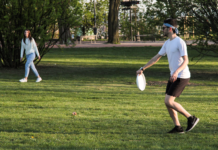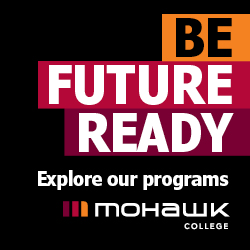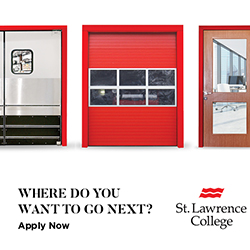With so many resources in Ontario, young students can do their research and start asking questions
There are few decisions in life bigger than choosing a college or university,
and the range of options can be daunting. There are 24 colleges and 21
universities in Ontario offering more than 3,000 programs of study, so where to start?
The Ontario Universities’ Info website and the Ontario Colleges website are
the best places to get underway. They provide checklists, key dates and links to every university and college in the province.
“The OUInfo website last year got more than two million hits and it’s had
14 million hits since September 2010, so we know it’s a huge resource,” said Deanna Underwood, manager of communications and events for the Ontario Universities Application Centre.
“The information there is updated by all Ontario universities and goes live
at the end of August for the coming school year.”
There are also reputable rankings of colleges and universities in publications such as Macleans, Times Higher Education and QS. All of that will give you a lay of the land and help narrow down your options. The next step is getting out from behind your computer.
Grade 12 student Tawhid Ahmed plans to attend post-secondary fairs, take campus tours and maybe even visit one of his older brother’s classes as he makes a decision about what comes after high school for him.
His father wants Tawhid to study at university but he’s also considering
college.
“I like hands-on. I can’t just sit at a desk. I need to do something with my hands.”
He’s leaning towards engineering and has relied heavily on advice from
guidance counsellors at his Hamilton high school, Bernie Custis Secondary
School.
“They’ve told me that it’s important I find something I am passionate about.”
Trish Wilson, head of student services at BCSS, says some parents are still of
the mindset that university is the most ideal path, but that’s based on outdated notions.
“If a student wants to go to college, they should get their parents to visit the campus to look at the facilities and talk to faculty. A lot of parents don’t understand the close relationship between colleges and universities.”
Educational and career counsellor Edie Kaus says many colleges offer degree path programs that are great for students who need practical, hands-on learning with smaller class sizes.
Start early
Students must submit their applications by January and February of their graduating year. Leaving all the research until Grade 12 isn’t feasible and will only lead to feeling overwhelmed and stressed and rushing a very important decision.
“There are so many programs out there and so many different models for how they are delivered. It’s so difficult to keep up with all of it,” said Kaus. “It’s a full-time job for me to do that.”
She starts working with students mid-way through their Grade 10 year. That’s an important time because Grade 11 courses are the first grades
examined by post-secondary schools and lead to prerequisites for first year.
She says students who have a program in mind should look at the courses they will be taking, the kinds of electives that are open to them, whether they can do a co-op. They should even look at the course outlines to see kinds of assignments they will be doing, and the methods of evaluations. Is it multiple choice tests or group projects?
“This is a very expensive endeavour, so put the necessary time into it,” says Kaus, a former leader of high school guidance departments.
Take advantage of fairs
The fall brings one-stop college and university fairs for prospective
students.
The Ontario Universities’ Fair (ouf.ca) and the Ontario College Information Fair (ocif.ca) have been doing an incredible job hosting virtual events allowing high school students and their families to meet faculty, students and staff from admissions, residents, sports and other co-curricular programs from each institution from your computer. The health and safety of everyone has been priority one. Planning is in the works for face to face fairs, please keep checking this and the OUF & OCIF websites.
Like the in person events, the online versions have are filled with information sessions about programs, admission requirements, paying for education, career planning, the application process and student life.
Don’t be shy, Wilson tells students. It’s your chance to interview your
potential choices (both virtually and when they are live events).
“Start writing down questions so that when you have the opportunity to talk to someone you are prepared. Be organized, keep a notebook with your
questions and answers.”
Not sure what to ask? The Ontario Universities Fair website includes questions to ask yourself about your strengths, interests, and goals and to ask university representatives, students and alumni about programs, finances, and campus life.
Recruiters from the universities and colleges also take to the road to visit high schools across the province, offering presentations and opportunities for students to ask questions. Be sure to ask your guidance counsellors for a schedule of visits.
Campus life
Do you want to be part of a big, bustling school or a small intimate one? Do you want a big-city campus experience or a quiet, self-contained one? How do you want to learn? Big lectures or small labs? Are you all about research, analysis and writing or hands-on experience and applied practice? Working alone or in teams? Universities and colleges hold open houses where faculty and students are available to talk to current students, and all labs and classrooms, residences and campus amenities are open to explore. You will know after spending a few hours wandering and asking questions whether a campus is a place you could picture yourself for the next three or four years.
“Anything within a few hours’ drive is worth the effort to see in person. You
really want a sense of whether you feel comfortable,” said Wilson.
If you can’t make an open house, students and their families can also book private campus tours hosted by current students. Check university’s websites for more information on in person and virtual open house.
While a campus visit is ideal, it sometimes can’t be achieved. So be sure to read thoroughly about the dorms, food, recreational and cocurricular activities on campus. Look at photos and watch videos. Try to track down current students or recent alumni to ask them questions.
Embrace this time
Kate Hatcher, a student success officer at BCSS, helps young people manage
the transitions into and out of high school.
“When students are panicking about all the choices and decisions they have to make, I tell them that (post-secondary) is an amazing experience and will be the best time of their life. Embrace it and know that there all kinds of supports along the way.”










